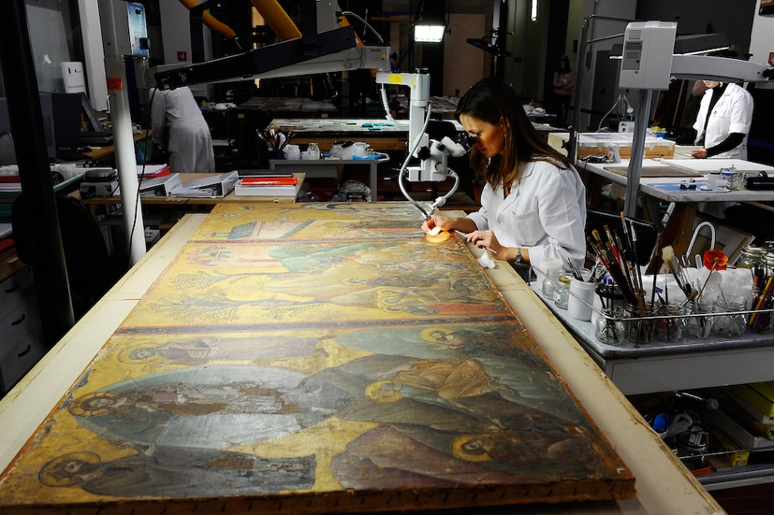意大利独特的文化遗产使其成为一座大型实验室,充分地体现了科学与技术如何应用于文化遗产的研究、保护、以及价值评估。2021年11月18日,由斯普林格《自然》出版机构主办的一场主题为“文化遗产的科学与技术”的学术会议在线上召开。1会议由《自然(意大利)》主编Nicola Nosengo主持,四位文化遗产保护领域资深的意大利专家受邀分享了他们的研究与实践经验。
罗马第一大学的考古学教授Marcella Frangipane以“考古学,卓越的跨学科科学”为题,率先介绍了考古学作为一个新的跨学科研究领域、一门“全球化科学”、以及一门人类学历史之本质。相关跨学科的前沿方法包括:用于原材料和制造技术鉴定的考古冶金学和考古学、景观和古环境研究、有机残留物的生物化学、人类和动物遗骸的古代 DNA 调查、骨骼和植物遗骸的同位素分析、以及微沉积学和微遗迹研究。她进一步以其意大利团队研究了60多年的世界遗产地阿斯兰特佩土丘(土耳其)作案例,展示了多学科方法带来的重要的研究发现 。2
意大利国家研究委员会文化遗产科学研究所的 Costanza Miliani教授以“应用尖端物理与化学保护艺术作品”为主题进行报告分享。她介绍了欧洲遗产科学研究基础设施(E-RIHS)的一个重要平台:“MOLAB移动实验室”3,实验室将意大利、法国、波兰、希腊和德国的设施组成统一管理网络,为艺术品和遗迹的现场无损检测提供便携式设备。接着,Miliani教授用四个不同时期和类型的艺术作品研究的案例,分享了先进物理与化学方法如何帮助研究者复原古代埃及蓝颜料、鉴别难以识别的古文献墨迹、有机染料-粘土混合颜料、以及分析画家J. Pollock泼墨画中的颜料胶合剂。
萨勒诺大学的Luigi Petti教授以“保护意大利遗产地免遭风险:案例研究”为主题作分享报告,并强调了《仙台行动框架2015-2030:减少灾害风险 (DRR) 战略和行动》中关于风险规避的四个优先事项: 1:了解灾害风险; 2.加强灾害风险治理以管理灾害风险; 3.投资以减少灾害风险并提高复原力(与资金有关);4.加强备灾以实现有效响应和“更好重建”。“帕埃斯图姆考古遗址”的研究案例介绍了3D测量、电断层扫描、探地雷达调查、3D探地雷达调查、地质学勘查,考古调查等现场实验测试、释放测试(研究结构刚性动态表现)等实验室测试如何帮助研究遗产地风险现状,以及用于海王星神庙的监测系统(运用UNISA Folded Pendulum敏感探测器技术)以及微震局部评估方法。Petti教授在第二个研究案例”庞贝考古遗址”的分享中,介绍了其所应用的长期灾害管理方法,包括:WebGIS – 数据和流程管理系统;地貌特征图;遥感监测;地表水文评估;用于现场调查的快速调查卡;以及其他各类调查和深入研究。他最后指出,风险管理流程包括四步:掌握知识,危害评估,监测监督,风险评估。这是一个动态过程,目的是长期的维护过程管理。
最后,意大利文化遗产技术中心的Arianna Traviglia教授以“人工智能时代的文化遗产”为题作分享报告。她介绍了人工智能、机器学习,空间技术在识别人工痕迹和鉴定潜在考古遗迹的巨大潜力。其技术中心不久前刚启动的“文化景观扫描项目”,旨在训练机器在海量的卫星图像中识别考古遗址特征,以加速工作进行。此外技术中心还在推进 “识别遗产非法掠夺项目”,旨在用人工智能在互联网上监测非法的文化遗产交易;Traviglia教授也介绍了“重建过去:人工智能与机器人遇到文化遗产项目”,旨在将成千上万块壁画碎片扫描,由人工智能进行虚拟拼合,并由机器人手进行实际复原。Traviglia教授最后总结道:“跟许多其他领域的变化趋势一样,人工智能、机器学习与文化遗产保护相结合是未来的必然方向。”
该会议不仅展现了意大利在文化遗产保护科学中的最新进展,也增添了公众接触文化遗产的渠道。
The unique cultural heritage of Italy makes it a big laboratory to show how science and technology can be applied to the study, preservation, and valorization of cultural heritage. Springer Nature organized a virtual conference titled “Science and Technology for Cultural Heritage, A Nature Italy Event” on 18 November 2021.[1] The event was chaired by Nicola Nosengo, chief editor of Nature Italy, while four senior Italian experts in different areas of cultural heritage conservation were invited to share their experience of conservation research and practice.
Marcella Frangipane, Professor in archaeology at the Sapienza University of Rome gave a talk titled “Archaeology, the interdisciplinary science par excellence,” in which firstly introduced archaeology as a new interdisciplinary research field, as a “Global Science,” and as an Anthropological History in nature. These advanced interdisciplinary methods include: archaeometallurgy and archaeometry for raw material and manufacture techniques identification, landscape and palaeoenvironment studies, biochemistry of organic residues, Investigations on ancient DNA on human and animal remains, Isotope analyses on bones and vegetal remains, micro-sedimentology and micro-remains studies. By using the case study of the World Heritage Site of Arslantepe (Turkey) where the Italian team studied for over 60 years, She further demonstrated how this multidisciplinary approach has brought important research discoveries. [2]
Professor Costanza Miliani from the Cultural Heritage Sciences Institute, National Research Council, gave a talk titled “Using cutting-edge physics and chemistry to preserve artworks. ”She introduced an important platform of E-RIHS (European Research Infrastructure for Heritage Science): the MOLAB (Mobile LABoratory),[3] which is a network of facilities from Italy, France, Poland, Greece, and Germany, providing coherent access, under a unified management structure, to a set of portable equipment and related competencies, for in-situ non-destructive measurements on artworks. She then used four case studies of various types from different historical periods to illustrate how advanced physics and chemistry could help researchers to reconstruct Ancient Color Egyptian blue, to read the unreadable Herculaneum papyri, to uncover the meaning in materials Hybrid clay-organic dyes, and to analyze the binding media in J. Pollock’s poured paintings.
Prof Luigi Petti from the University of Salerno gave a talk titled “Protecting Italy’s heritage sites from risks: case studies.” He emphasized the four Priorities in the “Sendai Framework for Action 2015-2030 Disaster Risk Reduction (DRR) strategies and actions:” 1. Understanding disaster risk; 2. Strengthening disaster risk governance to manage disaster risk; 3. The need to invest in disaster risk reduction for resilience (related to money); 4. Enhancing disaster preparedness for effective response and to “building back better.” He used the case study of the archeological site of Paestum, introducing how on-site experimental tests (i.e., 3D surveys, electrical tomography, GPR, 3D GPR survey, geologic survey, archaeological investigations), as well as experimental tests (e.g., release tests to understand the dynamic behavior of rigid bodies), helped researchers to study the conditions of risks. He also introduced the monitoring system for the Neptune Temple (using UNISA Folded Pendulum technology) and the Micro-seismic Local Assessment. In the second case study of the archeological site of Pompeii, he introduced the methods used for long-term risk management, including WebGIS – data & process management system, geomorphological features map, remote sensing activities, surface hydrology assessment, expeditious survey cards for the on-site survey, and various other types of surveys and in-depth studies. He finally pointed out that the Risk Management Process contains four steps: Knowledge, Hazards assessment, Monitoring surveillance, and risk evaluation.
The last speaker, Prof Arianna Traviglia from the Centre for Cultural Heritage Technology (CCHT) gave a talk titled “Cultural Heritage in the Age Artificial Intelligence.” She described the great potential of Artificial intelligence (AI), Machine learning (ML), and Space Technologies in identifying anthropogenic traces and detecting potential archaeological structures. She introduced the “Cultural Landscapes Scanner (CLS) Project” established recently, aiming to teach machines to identify the features of potential archaeological structures, which will accelerate and speed up the work. In addition, there are the “OPtimal Transport for Identifying Marauder Activities on LiDAR (OPTIMAL) project,” with the goal of detecting trafficking activities of cultural heritage on the internet, as well as the “Reconstructing the Past: Artificial Intelligence and Robotics Meet Cultural Heritage (REPAIR) project,” aiming to scan thousands and thousands of fragments of frescos, to virtually puzzle them together by AI, and reassemble them physically by the robotic arms. Prof Traviglia concluded that “As more and more as it is happening in lots of other fields and domain, artificial intelligence and machine learning will be our future for cultural heritage conservation.”
This conference not only demonstrated the latest development of cultural heritage conservation science in Italy, but it also created a wonderful opportunity to make cultural heritage accessible to the public.

会议海报插图
Conference Poster Illustration[4]
[1]观看线上会议详见To watch the conference on demand, see “Home - Science and Technology for Cultural Heritage, A Nature Italy Event.” Accessed December 7, 2021. https://conferences.nature.com/event/455f906b-6173-47c7-b248-b207d0d3a757/summary?RefId=NatItalypage.
[2]研究案例详见For more detail about this case study, see: Frangipane, M. Different Trajectories in State Formation in Greater Mesopotamia: A View from Arslantepe (Turkey). J Archaeol Res 26, 3–63 (2018). https://doi.org/10.1007/s10814-017-9106-2
[3] See Iperion CH. “MOLAB.” Accessed December 7, 2021. http://www.iperionch.eu/molab/.
[4]图片来源Image sourced from“Home - Science and Technology for Cultural Heritage, A Nature Italy Event.” Accessed December 6, 2021. https://conferences.nature.com/event/455f906b-6173-47c7-b248-b207d0d3a757/summary?RefId=NatItalypage.
